Create more engaging videos with simple, actionable scriptwriting tips.
Join 5000+ scriptwriting nerds reading “Write On Time”. Insights from writing for multi-million subscriber YouTubers sent to your inbox every Friday.
.jpg)
Chess Nuke
@chessnuke
30k+ Subcribers

Create more engaging videos with simple, actionable scriptwriting tips.
Join 2,200+ scriptwriting nerds reading “Write On Time”. Insights from writing for multi-million subscriber YouTubers sent to your inbox every Friday.
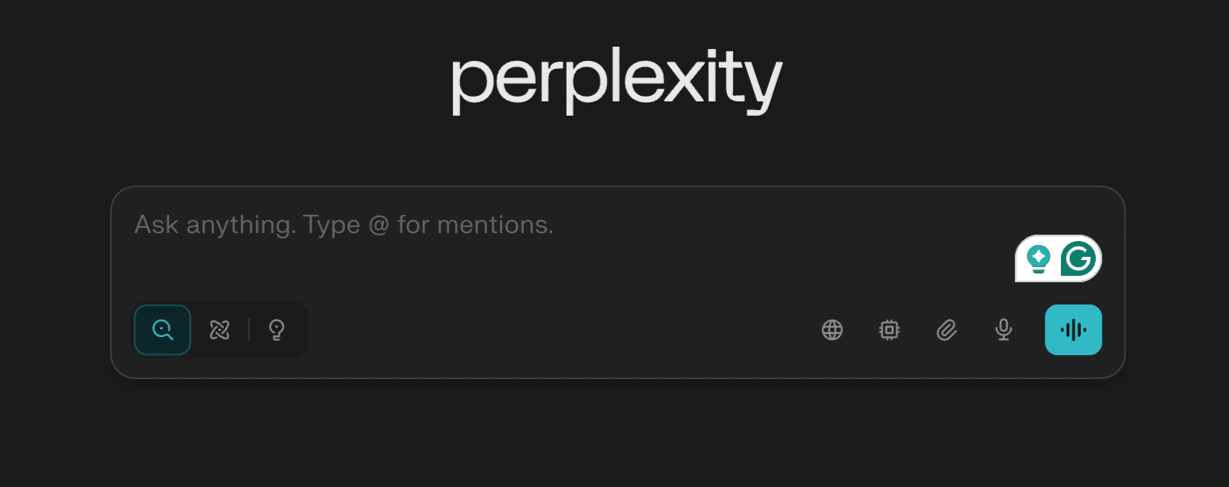
Use this tool to make script research FASTER
There's a free tool I'm using to "bulk out" my YouTube scripts that should be a no-brainer for your own arsenal.
You may already know about Perplexity, but I want to show you exactly how I'm using it in my scripts.
But first, what makes Perplexity different from ChatGPT or Claude?
On the surface, it looks very similar:
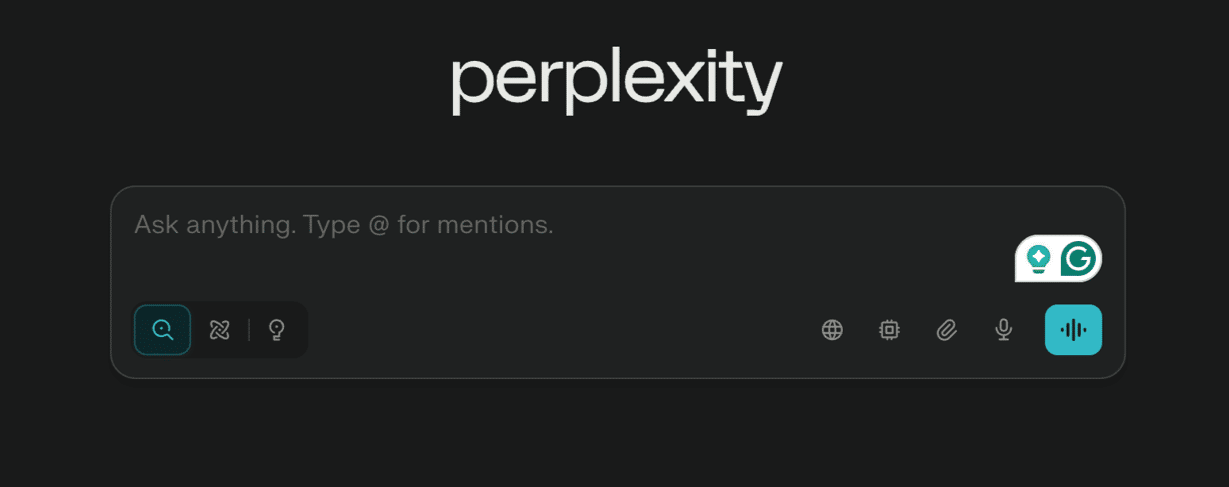
But, unlike ChatGPT (which has a tendency to "hallucinate" information) and Claude (which has an emphasis on more "human-sounding" dialogue), Perplexity is built around one thing:
Citations.
Perplexity must cite its sources for every single output.
It will cite a list of sources after every paragraph, a full list of sources at the end of its output, and you can highlight specific parts of its answers and ask it to cite the source it used for those words.
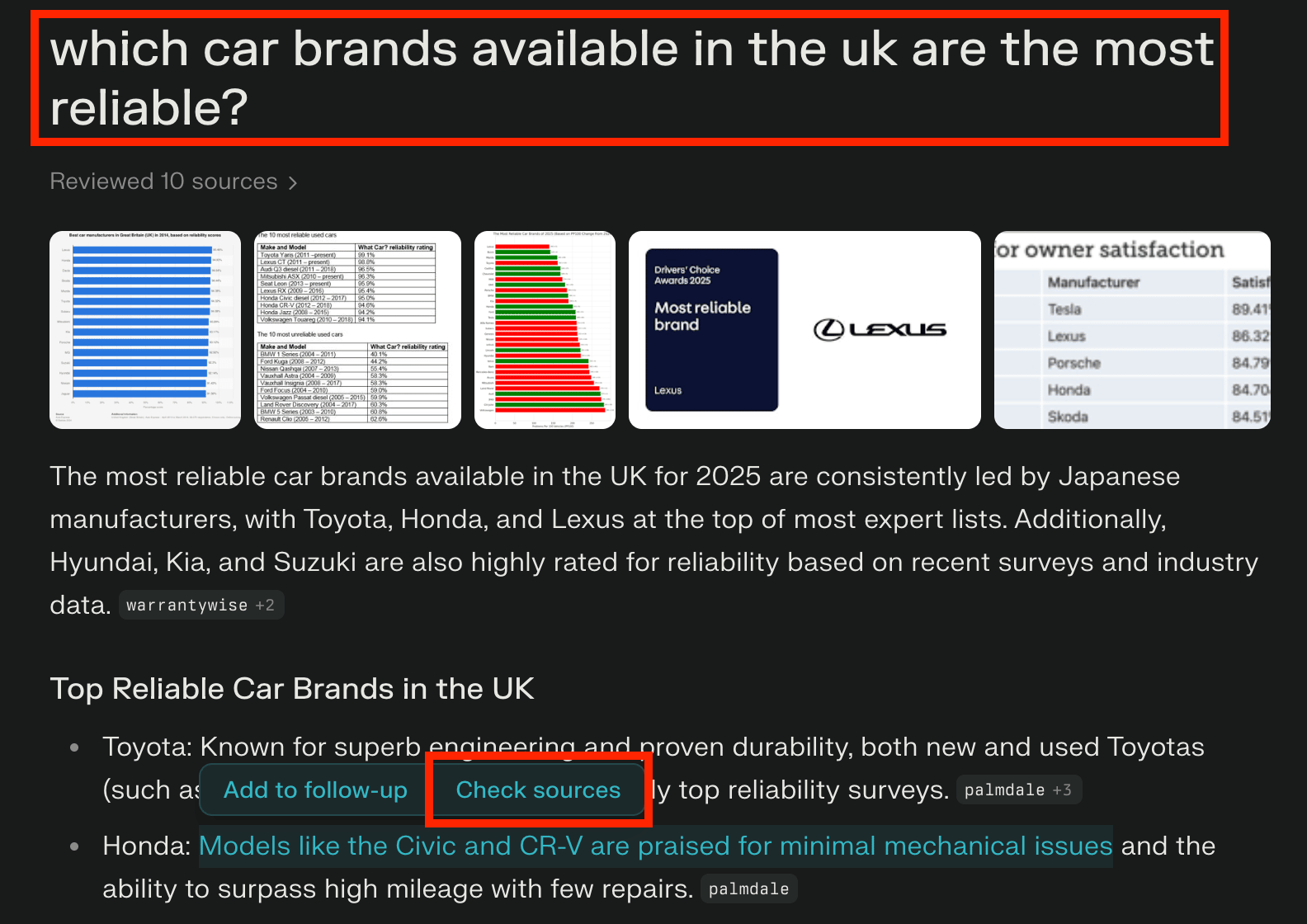
Perplexity is a gamechanging research tool for scriptwriting (and, I don't know, everything ever?!)
But here's exactly how I'm using it as a YouTuber...
How I use Perplexity in my scripts:
1/ To find things I've said in the past.
The key to my own consistency on YouTube has been to ensure I never write a script about something I haven't carefully thought about in the past.
Instead, I always convert a past newsletter or series of tweets - where I've already spent time thinking and writing about new concepts.
(I strongly encourage this practice by the way - if you're struggling to be consistent on YouTube, look to old pieces of your writing in any medium, and convert them to YouTube scripts.)
But sometimes I can't remember where I wrote about a particular topic.
Which is when I'll simply ask Perplexity to help me:
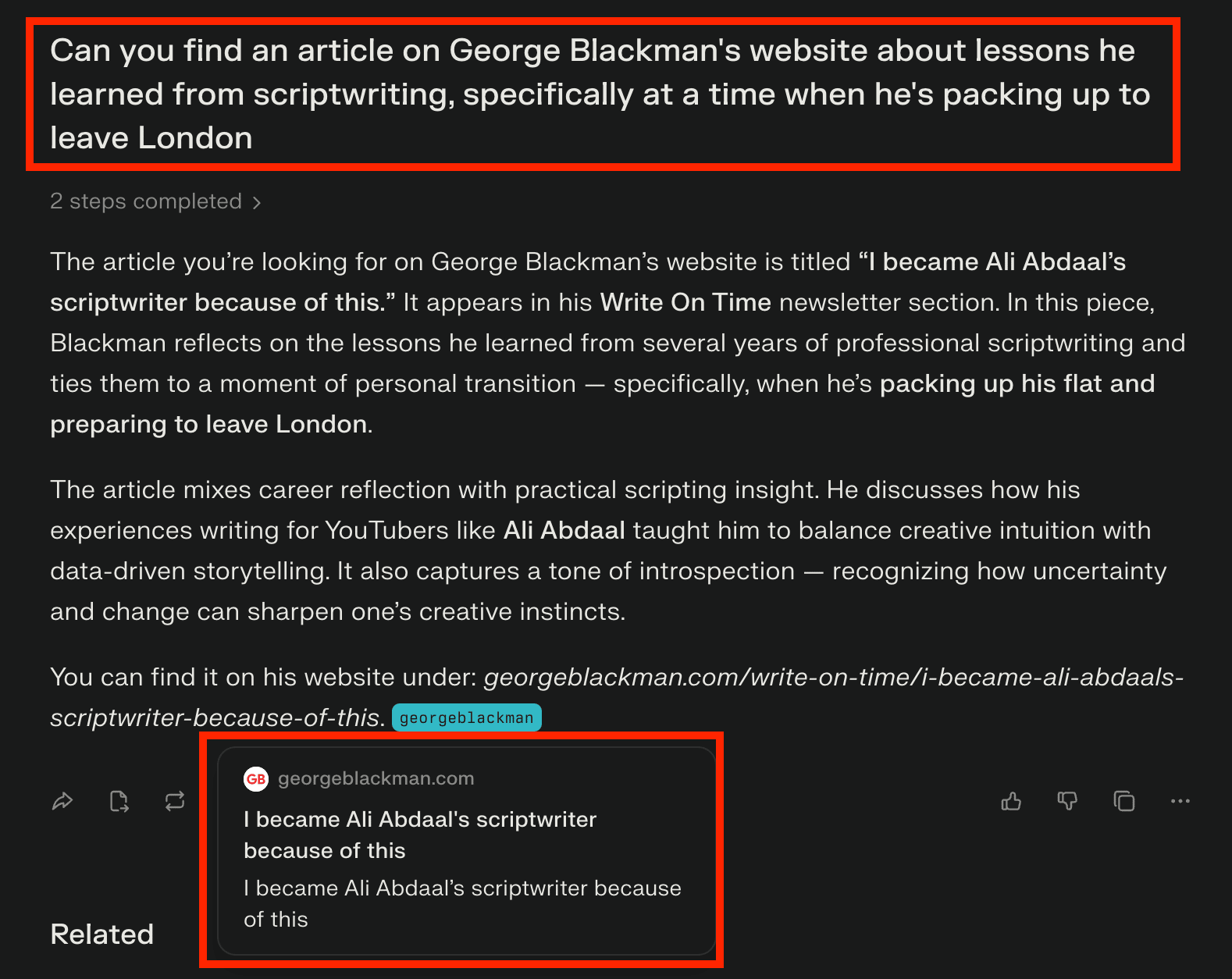
2/ Bulking out scripts with additional research.
If you need additional sources to back up a point you're making in a script, or simply a faster way to research a script, Perplexity shines once again.
I'll often describe a scriptwriting framework or retention principle I'm trying to teach, and ask Perplexity whether there's any scientific research (usually in the realm of psychology) that might help explain why the technique I'm teaching is effective.

There is a risk of confirmation bias here, so it's important to check the sources it's drawing on are reputable, but at least Perplexity does cite those sources so you can check.
Which is more than can be said for ChatGPT and Claude.
My Business Model Got Roasted on a Podcast 🎙️

I have a business dilemma.
For the last few months, I've been on the cusp of entirely rebuilding the marketing for my biggest revenue driver.
But, honestly? I'm scared to mess with a system that mostly works pretty well.
So, last week, I made an appearance on The Growth Question podcast, where my business coach Craig Shoemaker and his awesome co-host Jon Brosio helped me work out what to do.
If you're interested in hearing their advice, and how YOU could implement the exact same things in your business, I think you'll like this!
Watch It Here!
That's all for this week.
Have you used Perplexity yet? If so, how are you using it? Reply to this email and let me know!
Speak soon,
George 👋
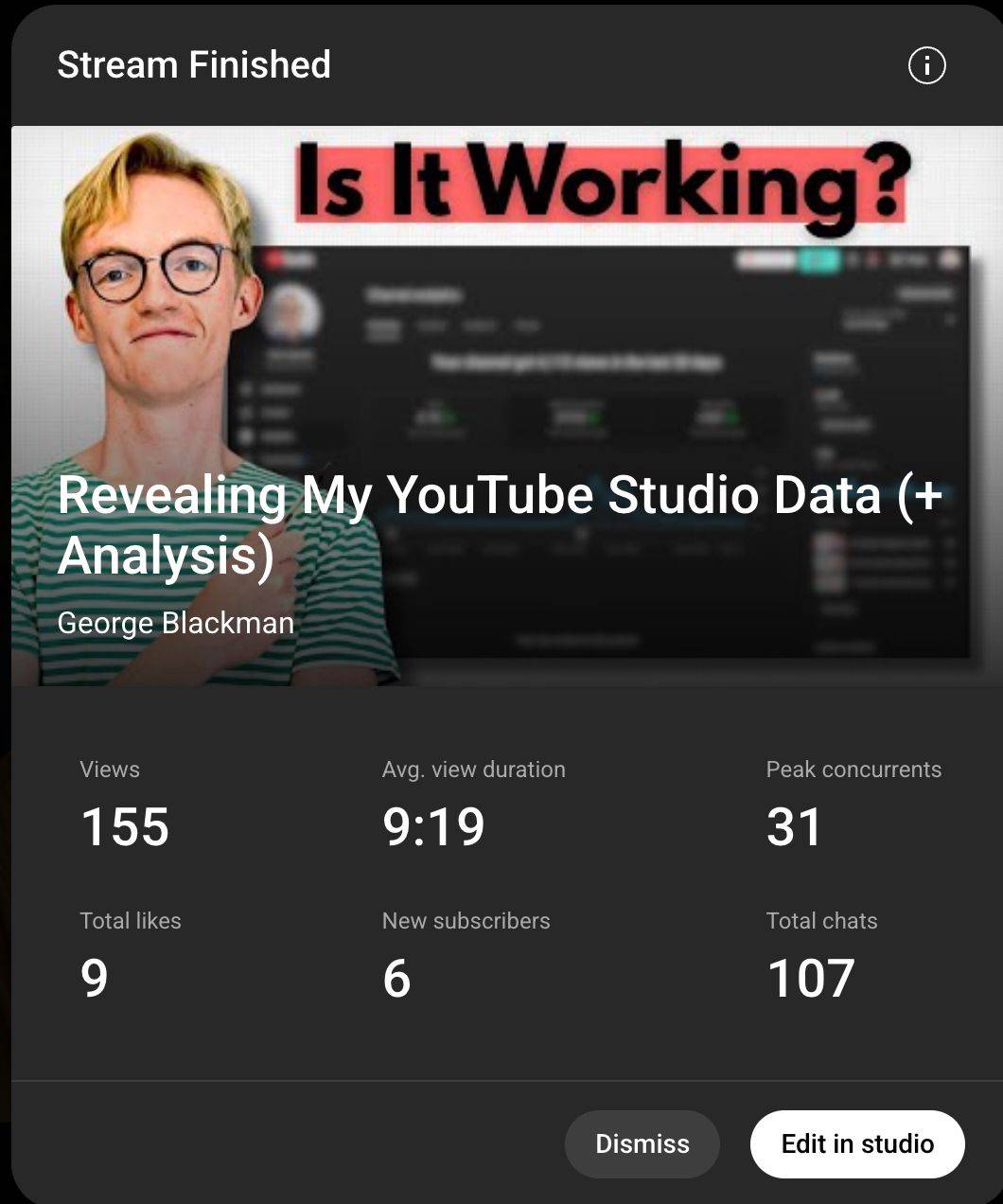
Is my YouTube channel actually working?
Last week, I went live and open-sourced my entire YouTube Studio!
We broke down:
- My fastest-growing video (and why it might have been a mistake).
- Retention issues, traffic sources, and end-screen CTR wins.
- Lead magnet conversions.
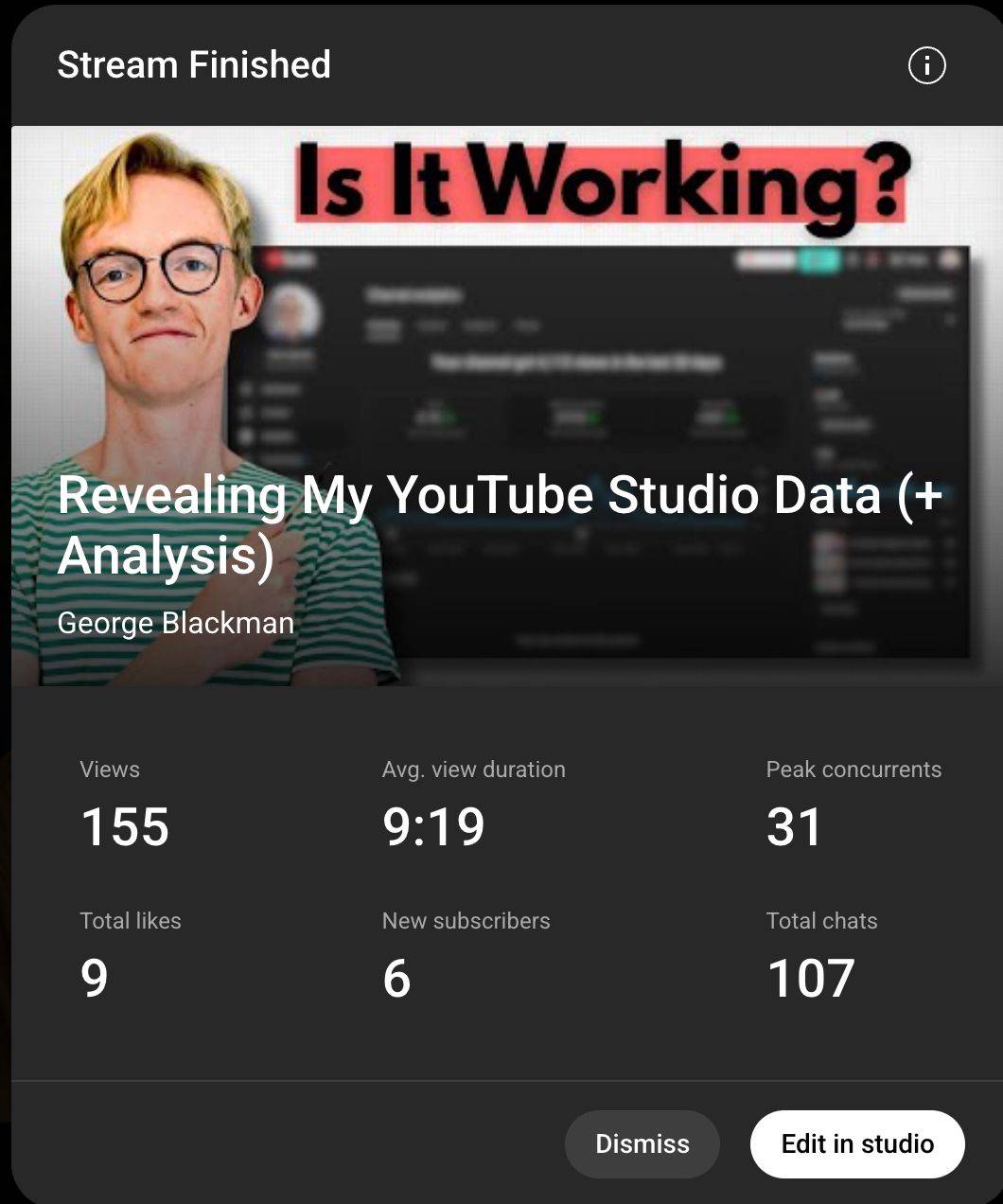
Missed it? Watch the Replay here!
Biggest takeaways:
1. Consistency is more important than individual stats.
As I hinted at in an earlier newsletter, my stats are all over the place:
- Poor first 30s retention (50-60%).
- Loads of new viewers, hardly any casual returning viewers.
- Suggested traffic coming from completely random videos.
On paper, it's a mess.
But, the reality is this:
YouTube doesn’t know who I am or who my videos are for yet.
If the platform doesn’t know who to show me to, then over-analysing tiny CTR differences or obsessing over early retention is procrastination pretending to be “strategy”.
So instead, I’ve set a very boring - but attainable - north star:
- Make a video every two weeks.
- Make those videos for a highly specific audience (like you!)
Everything else is secondary for now.
2. The Ali Abdaal video might have been a mistake.
My fastest-growing video is this one where I basically just rinse Ali Abdaal.
This did “well” in classic YouTube terms:
- Big initial views spike.
- Strong browse traffic.
- High CTR early on.
Then, all of a sudden... CTR dropped, browse fell off a cliff, and views dried up.
My read:
- The video benefits from Ali’s face and name
- It attracts “Ali fans”, not necessarily “I want to become a better YouTube writer” people.
Those viewers are much less likely to:
- Watch my nerdy scriptwriting videos.
- Join this newsletter.
- Become customers.
And, by seeing early positive results from an audience who would probably click Ali's face in any context, the algorithm later struggled to figure out which viewers to serve it to.
So yes, the Ali video is a “win” in that it brought more attention in the short term.
But in terms of helping the algorithm figure out who my channel is for, it's not ideal.
A video that gets fewer views from the right people is more valuable than a video that gets more views from the wrong people.
(And I even kinda knew I was shooting myself in the foot with this one... I just couldn't resist poking fun at Ali ONE more time, for old times' sake.)
3. There are SOME stats worth looking at.
Here’s what I am keeping an eye on:
a) Who my videos are being suggested next to
For the three launch videos, suggested traffic is now mostly:
- Other scriptwriting content.
- My own videos.
- My Jay Clouse interview.
Perfect. That’s what I want.
And I know I can increase the likelihood that my videos get suggested next to each other by:
- Adding them to playlists with each other, and other videos in my niche.
- Consciously making videos on similar topics.
- Using end-screens to link relevant videos together.
b) End screen click-through rate
Across the board, end screen CTR is high (often double digits, sometimes above 20%).
That tells me my structural frameworks and CTAs are working, so I don't need to change my approach.
c) Lead magnet conversion
Viewers who are downloading my free lead magnets, have provided me with some useful stats.
This lead magnet is converting at 77.6% 👇

Whereas this one is only converting at 60% 👇

My take on this?
The transformation suggested by the former is much clearer.
Ergo, I've updated the landing page for ScriptHook to try and create the same effect.
NEW VIDEO
The Easiest Retention Trick For Educational YouTubers

This video shows you a quick and easy retention trick that:
- Boosts watch time.
- Increases your authority within your niche.
- Increases the video's runtime (without you even trying).
That's all for this week.
Any questions? You can to reply to this email and I'll get back to you.
Speak soon,
George 👋
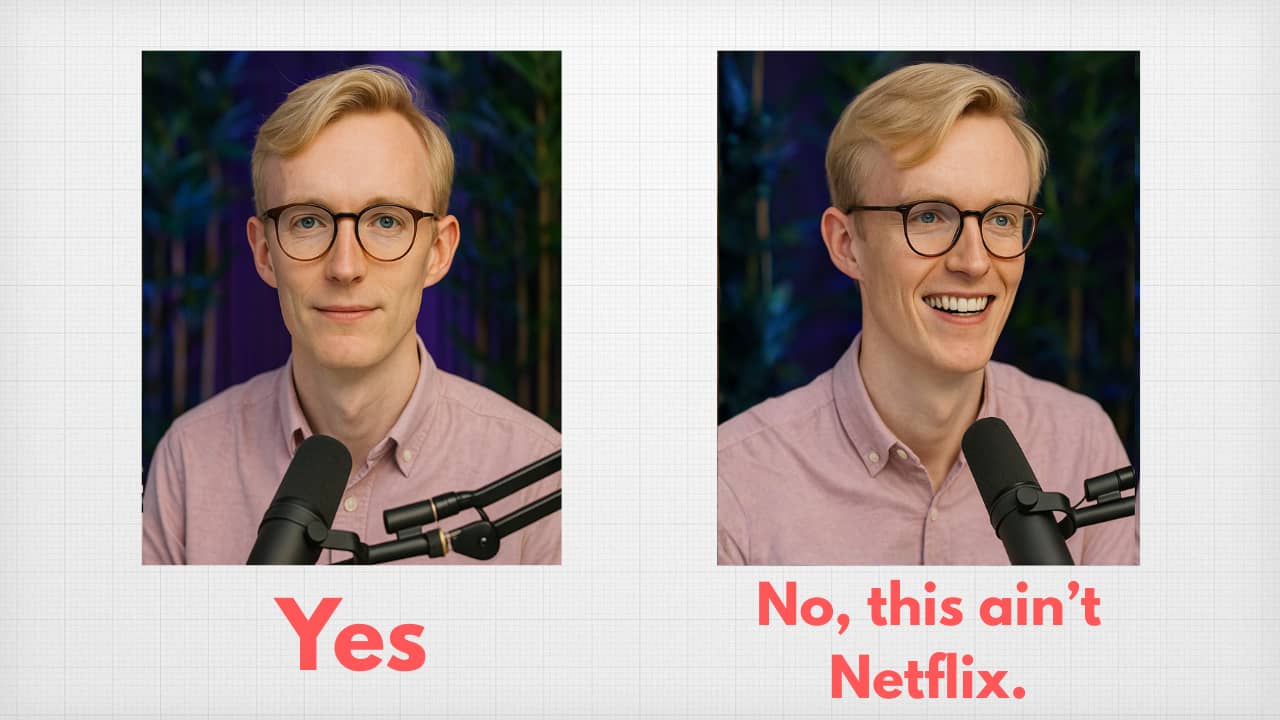
Don't let this wreck a perfect script
Sometimes, a well-written script can be wrecked by the editing.
Not by fancy effects, fast cuts or other creative choices.
But by overusing (or misusing) the simple visuals I'm about to reveal.
Here are the 7 easy-to-miss visual mistakes that I've repeatedly seen wrecking retention (so you can tell your editor to avoid them).
1/ Text appears out of sync with your voice.
Let's say you're using text to reinforce a payoff you're delivering at the end of a segment.
The audio (you speaking) and the visuals (text appearing) must be synchronised.
Yet I've often seen text appearing faster than the YouTuber is speaking.
But why is this a problem?
The reality is, your viewers can scan text faster than you can speak.
So if the text has fully appeared before you’ve finished speaking, the viewer will get bored waiting for you to finish saying what they already read.
Ideally, text should appear exactly in sync with your voice.
BUT, if it has to skew one way, it’s better for the text to appear slightly slower than your voice.
2/ Relying on stock B-roll that hides your face.
Truly... TRULY... static A-Roll is preferable to impersonal, boring, ten-a-penny B-Roll.
An online inspiration of mine, Kieren Drew, recently started on YouTube, and his videos are packed with incredible information.
But, as a YouTube newbie, he's falling for the "B-Roll is better" trap.
In the first 5 seconds of this video, he's disappeared from the screen entirely, and we're left watching a rotating cycle of generic B-Roll.
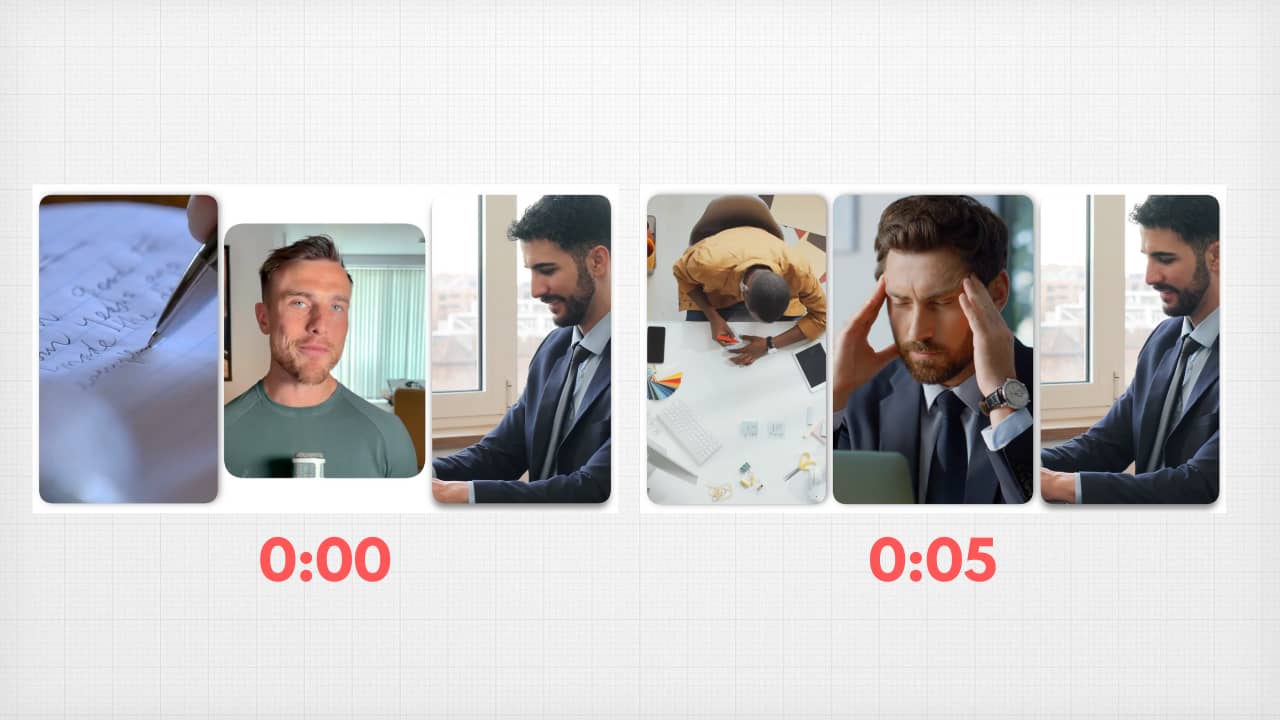
The fact that stock footage makes the visuals "varied" doesn’t “hack” my attention… it just makes me lose my connection to you.
3/ Text almost matches the audio (but doesn't).
I’ll often see a YouTuber begin a segment saying something like this:
- “Next, let's talk about the very worst thing to do right after your first ayahuasca session.”
Meanwhile, the text used to reinforce this says:
- “Just done ayahuasca? Avoid this for 24 hours!”
The problem is, if your viewer notices a discrepancy between what they see and what they hear, they're likely to ascribe meaning to it, assuming it's something you've done deliberately.
This is a psychological phenomenon called "illusory pattern perception", where meaning is derived by the observer, even if there is no meaning.
And even the 0.5s it takes them to verify that what they saw and what they heard were saying the same thing, but in slightly different ways is enough to cause "comprehension lag".
In that time, they've missed the next thing you said, and they now have to try and catch up.
So make sure on-screen text headings like this contain highly similar vocabulary to your spoken word (e.g. "The Worst Thing to Do After Ayahuasca")
4/ Confusing visual “language”.
Recently, I saw a video that used a small “checklist” style graphic in the hook to represent the key points he would reveal during the video.

So far, so good - this helps illustrate the video’s structure.
But then, he used the same graphic later to create an entirely different “list” related to a different topic.
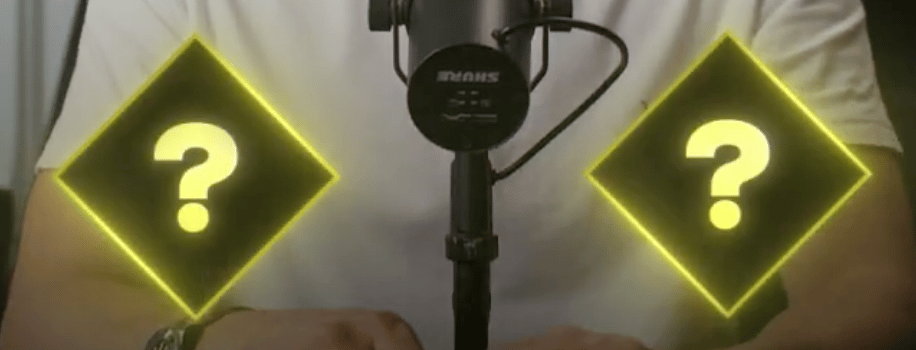
Avoid this at all costs.
If you’ve used a graphic during the hook to help create a sense of the video’s structure, do not use that same graphic for another list within the same video.
5/ Lots of text with no visual guide indicating what to focus on.
For example, if your video contains a screen-recording of an article, or a large wall of text in any other context.
You must guide your viewer's eye to the relevant text, even if you're reading it out.
Otherwise, our eyes will wander and we'll lose track of what you're saying.
6/ Including a second camera angle to make it look like... you're being interviewed for a Netflix show?
Ok... I have no retention-based evidence that this is bad.
And I know it's helpful to cut between angles so you can hide any mistakes.
But it looks kludgy af and you should stop it 😆
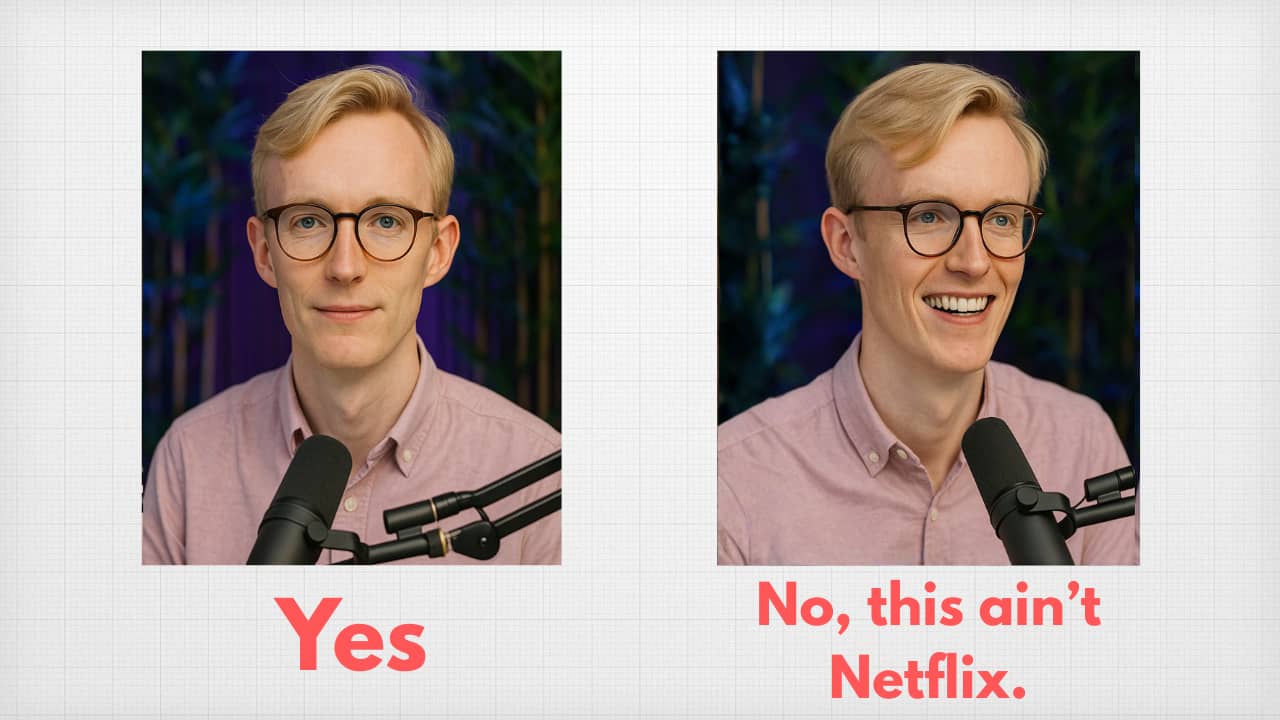
7/ Text is thrown on-screen for the sake of it.
Whenever we put text on-screen, this ascribes it a degree of importance.
So overusing text will reduce its effectiveness in moments that truly do matter.
Ergo, be picky with when you use text - on my channel, I’m pushing towards only using it in 3 instances.
- Hook checklist.
- Chapter opener.
- Lower-third takeaway.
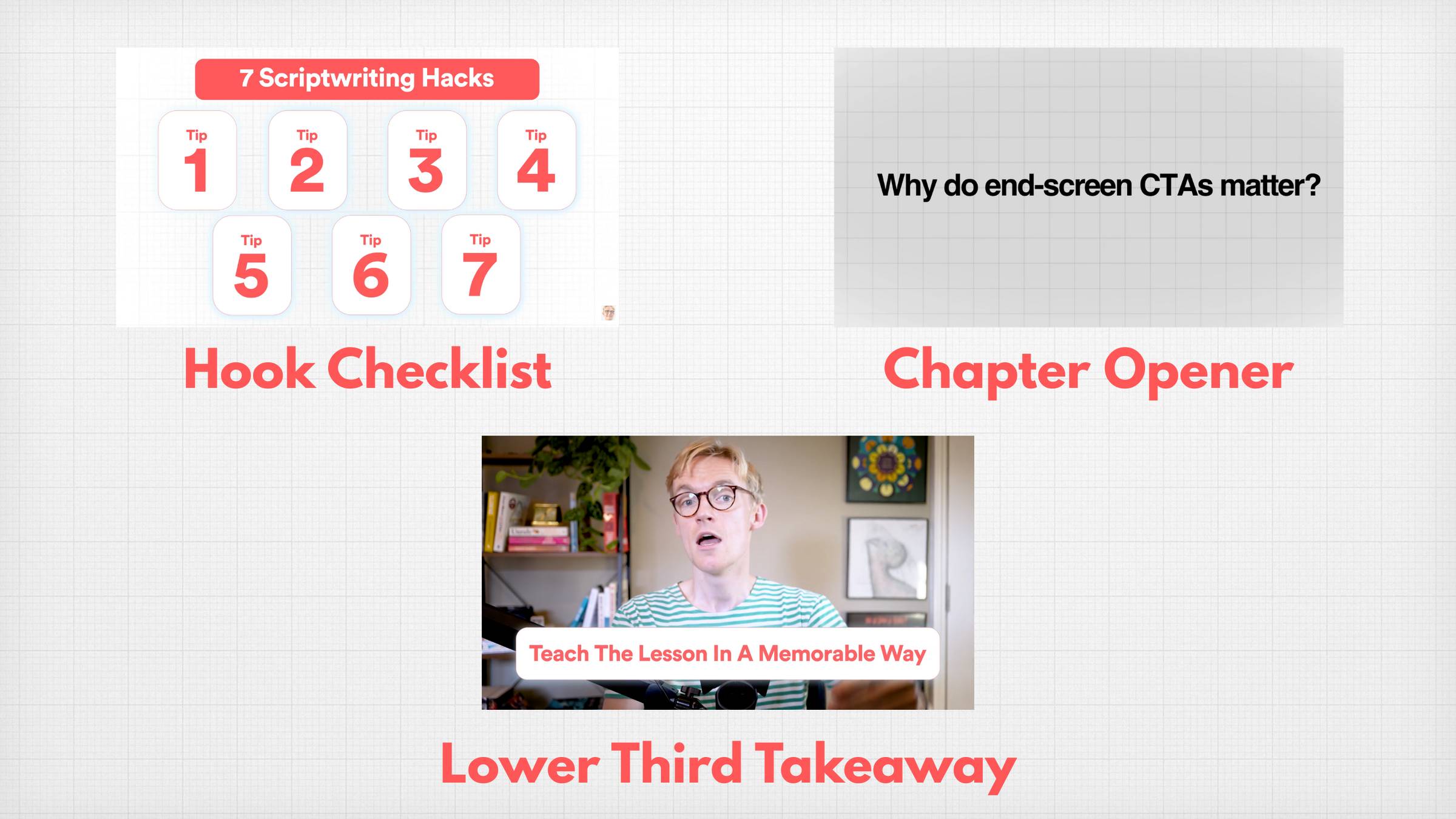
Remember: if a visual isn't actively increasing the viewer's clarity, it's either doing nothing - or it's reducing their clarity.
That's all for this week.
Any questions? You can to reply to this email and I'll get back to you.
Speak soon,
George 👋

Why I’m ignoring my YouTube Studio data.
There will come a moment in your YouTube career where you face a difficult decision like this one.
So stick with me for this quick story, because you never know when it might come in handy.
This week, I had a conversation with a scriptwriting student of mine.
He was trying to figure out what type of content to make in the next 6 months, but had run into a problem that you might recognise.
Here's a (paraphrased) version of our conversation:
Student: “I want to grow my channel faster.”
George: “Ok. Why?”
Student: "To funnel more clients into my program.”
George: “Great, what’s your program about?”
Student: “It’s about [A]”
George: “Perfect. So make videos about [A]”
Student: “Oh but here’s the thing, you delightful idiot-” [he didn’t say that part] “-my best performing video is about [X], so if I want to grow my channel faster and make more sales, shouldn’t I just make more of that?”
George: “Would that video appeal to the audience you’re trying to build?”
Student: “No.”
George: “Or the clients you’re trying to reach?”
Student: “No.”
George: “Do you want to make that video?”
Student: “Oh, definitely not - it’s actually annoying that people associate me with [X] when I’m trying to sell [A].”
Now, the solution to this problem does look pretty simple when summarised like this, doesn’t it?
“Stop making videos about [X]; make videos about [A].”
But, when it comes to YouTube, we are constantly told to follow the signals.
And this... can be confusing in moments like this.
Of course, we DO want our decisions to be guided by data. But data can be distracting.
I know this because I’m going through something similar to my student right now.
I’ve just launched my own channel, and… YouTube doesn’t know who the hell I am yet.
That means I'm receiving "signals" from YouTube that would usually convince me to change course. For example:
- My first 30s retention is terrible.
- I have 90% new viewers, almost no casual or returning.
- And, when I dig into the data a little, I can see one of my videos is being recommended by another called “Cool Uncle Mods: Jailbreaking the Kindle 4”.
These signals are confusing.
Or, they would be... if I weren't choosing to ignore them completely.
So, why am I ignoring the data? Well... it's actually quite simple.
I have my ideal audience in mind, and I accept that it’s going to take 2-3 months of relentlessly, consistently staying the course to find them.
That means:
- Uploading videos for the audience I want to build (and only them).
- Scripting my videos to speak to the customers I want to attract.
- Accepting that this will not happen overnight, and therefore remaining devoted to my guiding direction.
Once I find (or, rather, YouTube finds me) the audience I need, then I can listen to the signals.
I'll get bogged down in YouTube Studio figuring out how to fix my retention, my CTR, and my idea selection.
But for now, direction supersedes data.
Likewise, everything in my students’ data is telling him to make more videos about [X].
But that data is not valuable to him anymore, because he wants to build an audience who care about [A].
Again: Direction supersedes data.
All this to say, there will be moments where you have to choose to ignore your data.
And that’s really difficult.
But when the time comes, I know you’ll do it - if you have a bigger, more important directional goal for your channel in mind.
And, if you’re interested, here’s me staying the course in my latest video (dropped today!):

That's all for this week.
Any questions? You can to reply to this email and I'll get back to you.
Speak soon,
George 👋
P.S. Newsletter cutting room floor here. I was trying to get this metaphor in somewhere, but I lost confidence that it actually made any sense. Anyway, see what you think:
“If I was sailing from Ireland to Canada, I wouldn’t dock in Greenland just because they had a nice shiny lighthouse.”
Put that on a T-shirt and smoke it!
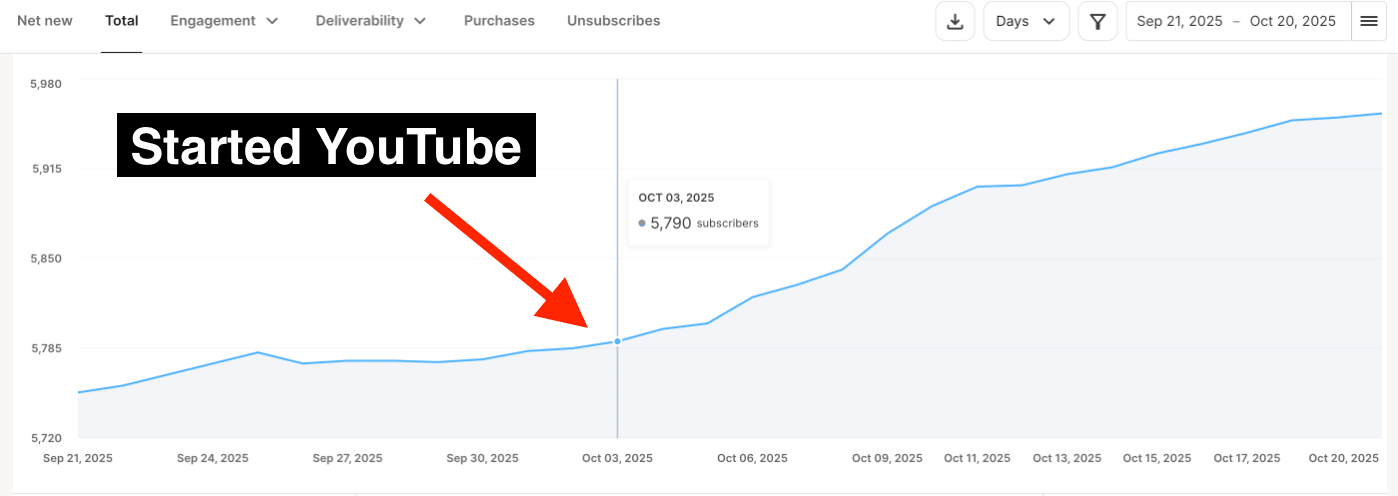
YouTubers: don't let Instagram distract you
YouTube is 31x more efficient at generating leads for my business than Instagram.
(And it's got a lot to do with how easy it is to write an effective CTA.)
Let me explain:
22 weeks ago, I started my business Instagram with the intention of replacing the traffic I used to get from Twitter.
(Miss u, Twitter xxxx)
The perceived "lower effort" of writing and filming a Reel (vs a YouTube video) drew me in.
But, after figuring out a more efficient system for writing YouTube scripts in less time (a combination of my YTSP scriptwriting system and the advice I give in this video)...
...I re-launched my YouTube channel as well.
So this week, I wanted to crunch the numbers.
Even at this early stage, I wanted to know:
- Which platform had been more effective at generating leads.
- How much time input was required per lead?
(I mean, between you and me, I knew YouTube was going to win... 👀)
...but the extent of the victory shocked me 😆
In the below stats, a "lead" is somebody who joined this newsletter via a lead magnet promoted by the piece of content.
Instagram (started 22 weeks ago)
- Videos: 11
- Views: 4500
- Leads: 4
- Average time to script + film one video: 70 minutes
Average time input per lead: 192.5 minutes
YouTube (started 3 weeks ago)
- Videos: 4
- Views: 2300
- Leads: 79
- Average time to script + film one video: 120 minutes
Average time input per lead: 6.1 minutes
Ok, so... let's address the elephant in the room.
"You only made 11 Reels and gave up."
True. But is it any surprise?
Instagram nerds will tell you that, to properly grow on Instagram, you need to post daily.
So, assuming you only have 3-4 hours per week to write and film content...
...Instagram is a non-starter.
YouTube, on the other hand? 😍
3-4 hours per week is plenty of time for most channels to write and film a video (again, combining my writing system + advice hyperlinked above).
And approx. 1 video per week has already had a non-trivial impact on newsletter sign ups and even sales.

And my channel is still tiny.
Some of you, reading this, will already know exactly how impactful YouTube can be at 100x these numbers.
But why is there such a disparity?
My business is just a single example, but I don't think it's atypical.
And I believe it comes down to two key factors across both platforms that grossly affect how many leads they generate:
1/ How easily can you convince the viewer to click?
- YouTube: Viewers build more trust from a single piece of content. When you're delivering 10 minutes of value, the viewer has more patience to listen to a 15 second plug.
- Instagram: Viewers have less time to build trust. Plus, while already trying to cram a tonne of information and nuance to a short video, you probably only have 3-5 seconds to include a plug.
Takeaway: Long-form YouTube content, as a medium, is just better set up to build trust and allow you space to script a convincing plug.
2/ How physically easy is it for the viewer to click?
- YouTube: QR codes on-screen allow TV viewers to "click", and links in your description + pinned comment make it way easier for PC and mobile viewer to click.
- Instagram: Viewer can navigate to your link in bio, or a third party tool like ManyChat can be used (but these require the viewer to comment to receive the lead magnet).
Takeaway: YouTube viewers can access your links with a single click. For Instagram users, there's more friction.
All that being said... I still have a presence on Instagram.
My partner, Julia, converts all my newsletters into carousels, and we double-post those on LinkedIn as well.
There's no harm in keeping a presence elsewhere, if it doesn't distract you from the highest leverage platform (YouTube).
So... if you want to see my highest-converting lead magnet so far, check out this video:
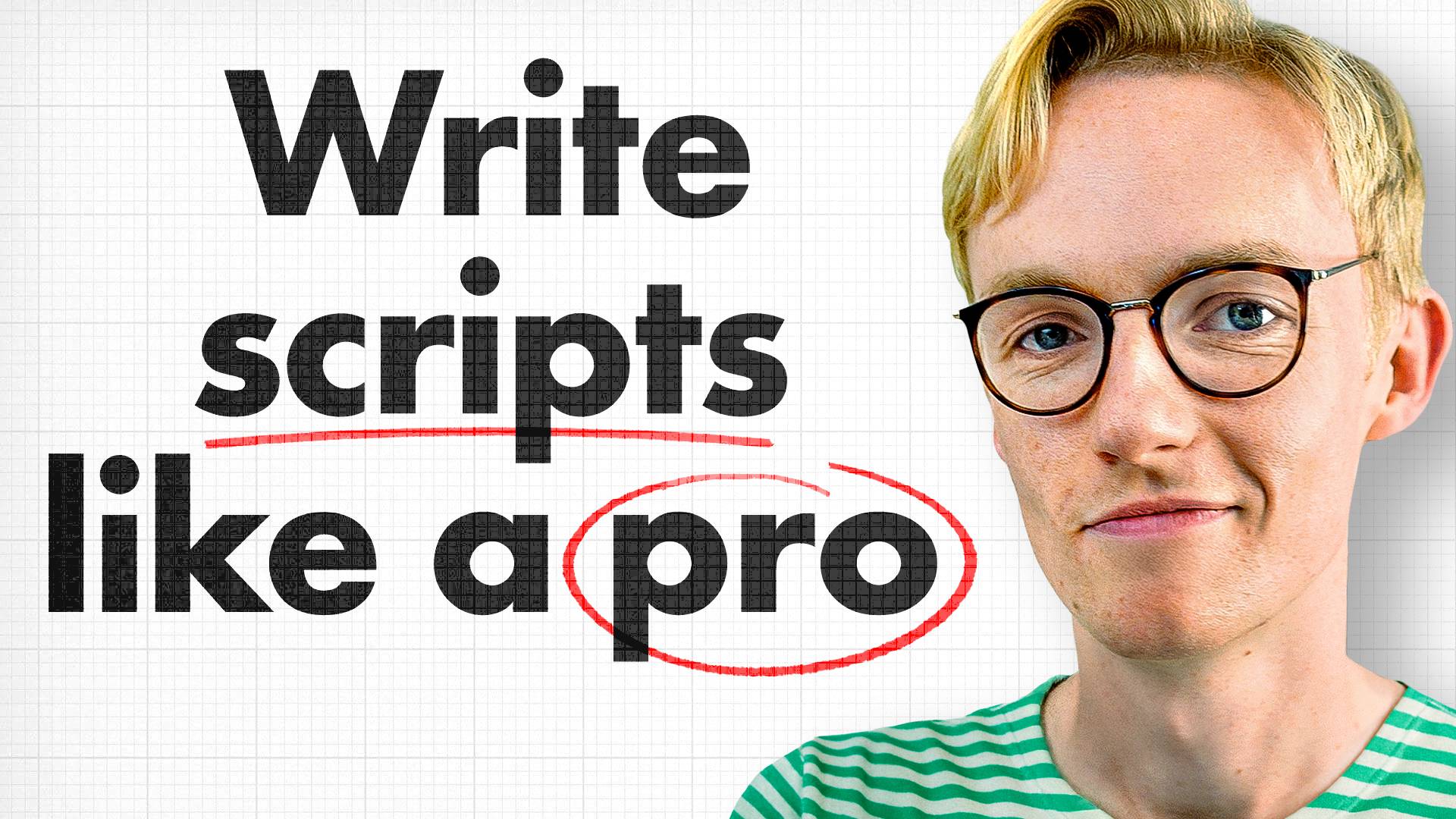
Watch the video here.
The cool part is... I never explicitly tell the viewer to click the link.
But, because of the natural trust-building format of long-form YouTube content, a simple link at the top of the description is sufficient.
That's all for this week.
Any questions? You can to reply to this email and I'll get back to you.
Speak soon,
George 👋
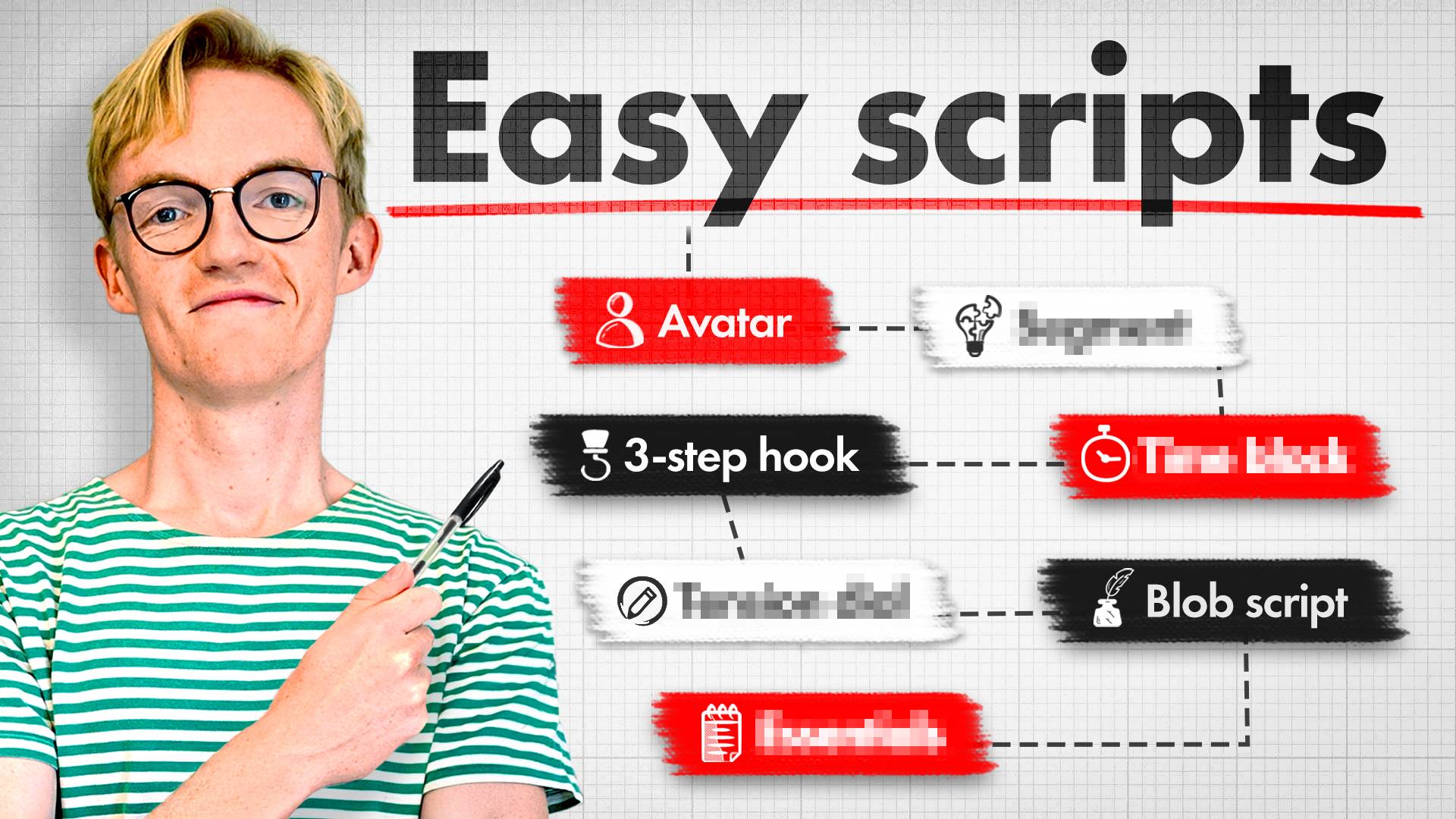
The hook mistake made by 100k+ channels
Today, I've got something essential to keep in mind when writing your next hook.
Specifically, if your hook ends with a "rule of three".
A rule of three usually appears at the end of a hook and sounds like this:
"So in this video, we're going to cover:
- [Topic 1]
- [Topic 2]
- And [topic 3]"
Having a video that answers multiple questions like this is great because:
- We can really sell the amount of value in our video.
- We can set up the video's structure, which is essential to keeping the viewer oriented and engaged later.
But here's the problem:
The choice of which three things you mention is more important than you'd think.
It's not as simple as choosing "the most interesting three topics from the video".
And I've seen channels with 100k+ subscribers get this wrong (and their retention has suffered because of it).
For example, let's imagine a video called "Best laptop for small businesses in 2025".
In the past, I've seen channels who made the mistake of writing something like this at the end of their hook:
"So in this video, we're going to cover:
- The huge problem with Sony laptops in 2025.
- The unexpected realities of Apple's new M5 chips.
- And which laptop is right for small business owners in 2025."
But... why is this a problem?
All three bullet points sound exciting and, more importantly, relevant to the topic.
But here's the issue:
While it might feel like a good idea to pick the three most exciting topics from your video and mention those at the end of your hook, this can actually disrupt the viewer’s sense of the video’s structure.
(And, remember, structure is key to retention - and setting up that structure in the hook is essential.)
By putting three equally important topics side-by-side, it makes it more difficult for the viewer to latch on to the primary question.
The primary question is the reason they clicked - and it's probably the question expressed in the title (in this case, "which laptop should I buy as a small business?")
Instead, the rule of three should include two supporting questions and then the primary question.
In our laptop example, it might look like this:
"So in this video, we're going to cover:
- The key features of each laptop.
- How their spec will affect your day-to-day workflow.
- And, ultimately which laptop is right for small business owners in 2025."
As our video progresses, we want our viewers to retain complete clarity about why they're watching.
And muddying the waters in the hook by expressing three equally important-sounding ideas makes it more likely they'll lose that clarity later on.
That's not to say that our laptop video can't include discussions about "the problem with Sony laptops in 2025", or "the unexpected realities of Apple's new M5 chips"... but we should avoid using these in our "rule of three" during the hook.
I've got two more quickfire examples below if you're still not 100% clear on what a "good" vs "bad" rule of three looks like, but first...
New Video Just Dropped
7 YouTube Scriptwriting Hacks (from 40m Views)
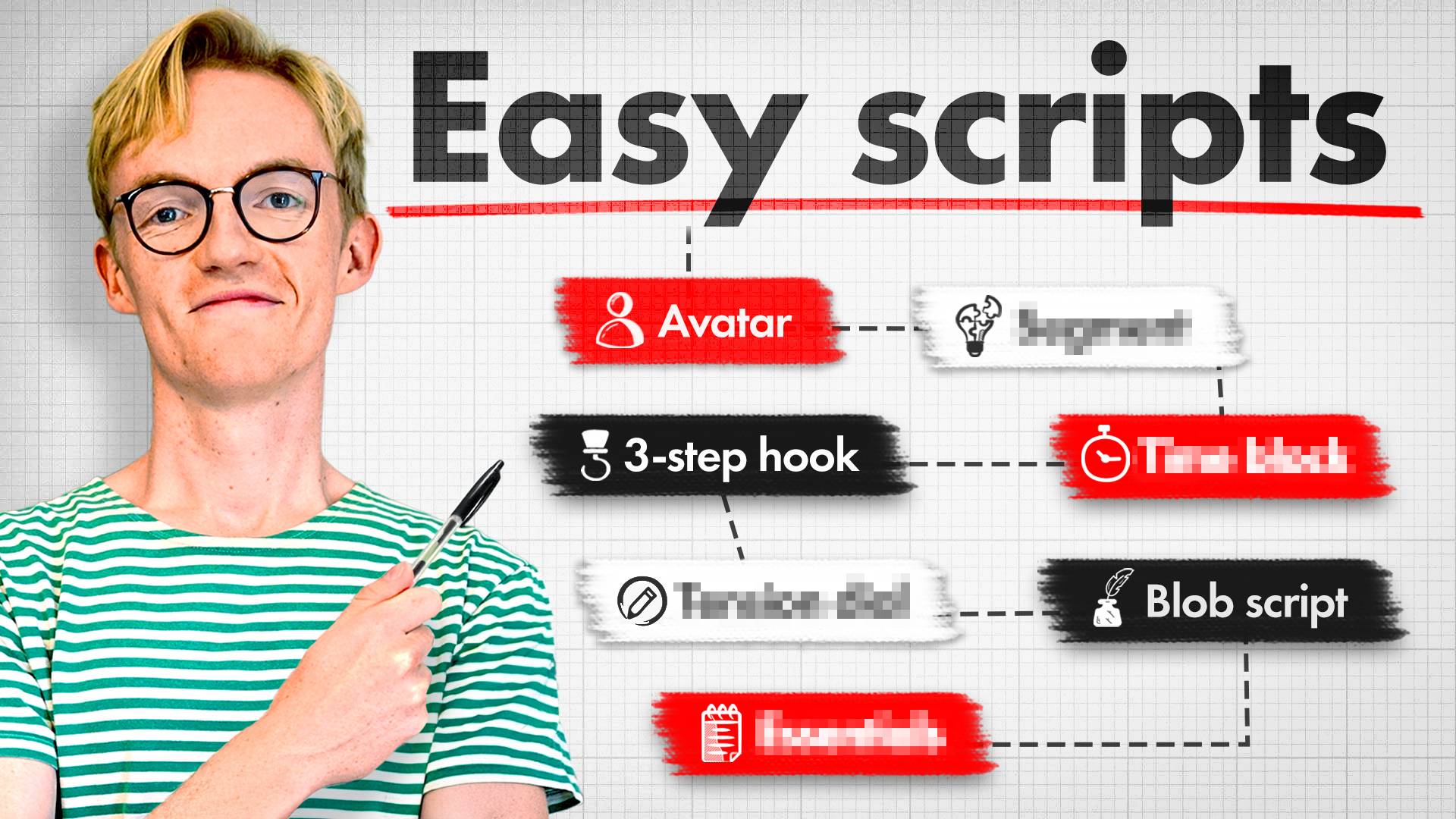
After launching my channel two weeks ago, video #4 just dropped. Feel free to check it out!
Quickfire Examples: "Good" vs "Bad" Rule of Three
Title: How to Stop Procrastinating and Actually Get Things Done
❌ Bad rule of three:
“So in this video, we’ll talk about:
- The best productivity advice I ever received.
- The daily habits of highly successful people.
- How to stop procrastinating and actually get things done.”
All three sound like different videos, and I might even be more compelled by the first bullet than the third.
✅ Good rule of three:
“So in this video, we’ll talk about:
- The common triggers that cause procrastination.
- What’s really happening in your brain when you procrastinate.
- How to stop procrastinating and actually get things done.”
The first two ideas flow naturally into the third.
Title: THIS Is Why You Can't Build Muscle Consistently
❌ Bad rule of three:
“So in this video, we’ll talk about:
- How sleep impacts your metabolism.
- Why you're probably tracking your workouts wrong.
- How to finally start building muscle consistently.”
As above, my attention is pulled equally to bullets 1 and 2 as it is to bullet 3.
✅ Good rule of three:
“So in this video, we’ll talk about:
- How to set effective calorie targets during your training.
- How to avoid overtraining so you don't waste your progress.
- And, ultimately, how to start building muscle consistently.”
The first two ideas flow naturally into the third.
That's all for this week.
Any questions? You can to reply to this email and I'll get back to you.
Speak soon,
George 👋
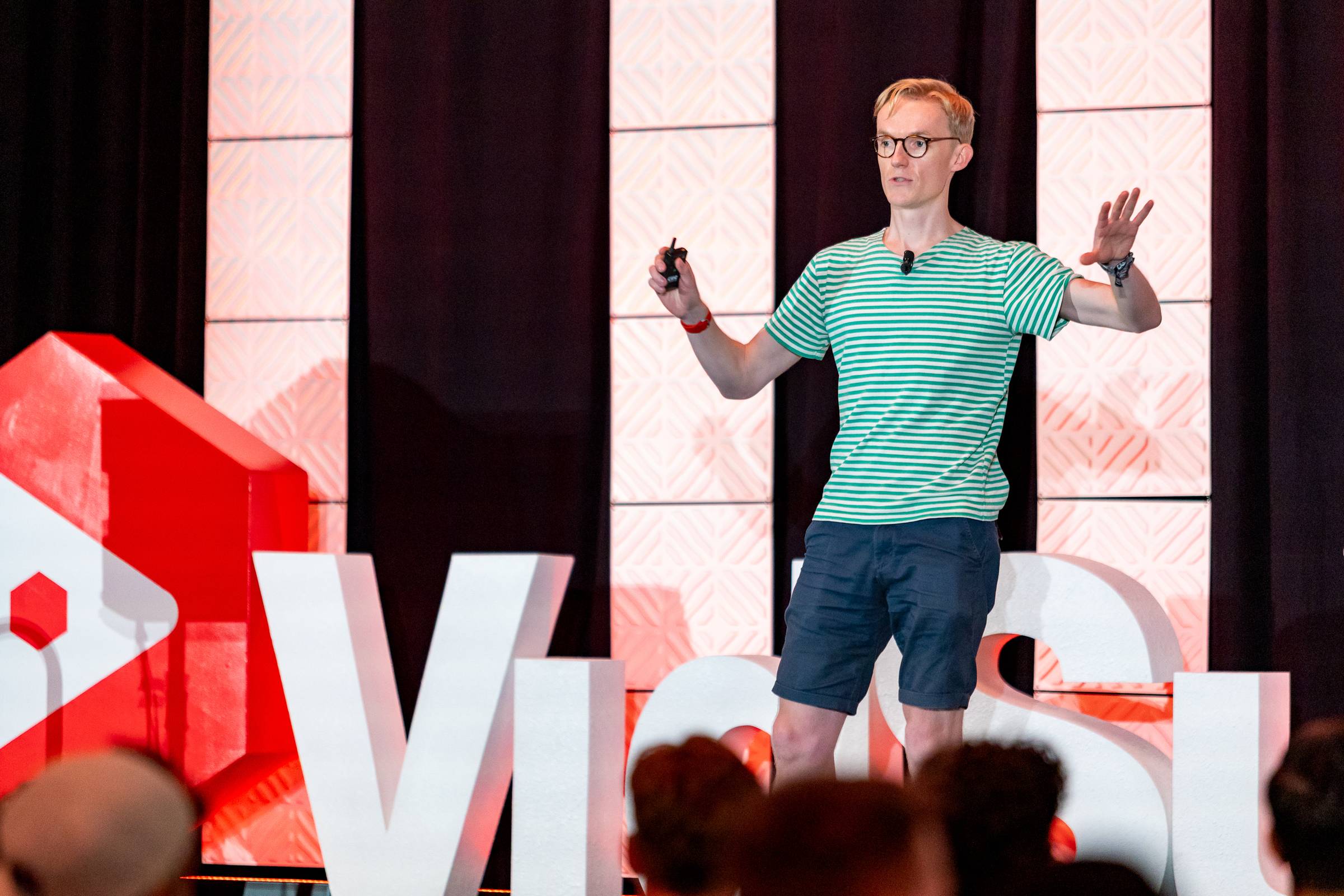
I spoke at YouTube's biggest insider conference!
I know you wouldn't normally hear from me on a Saturday, but it's been a heck of a week!
Today, I simply want to thank you 🙏
This week, I had the privilege of attending VidSummit to deliver a talk about YouTube Scriptwriting and AI.
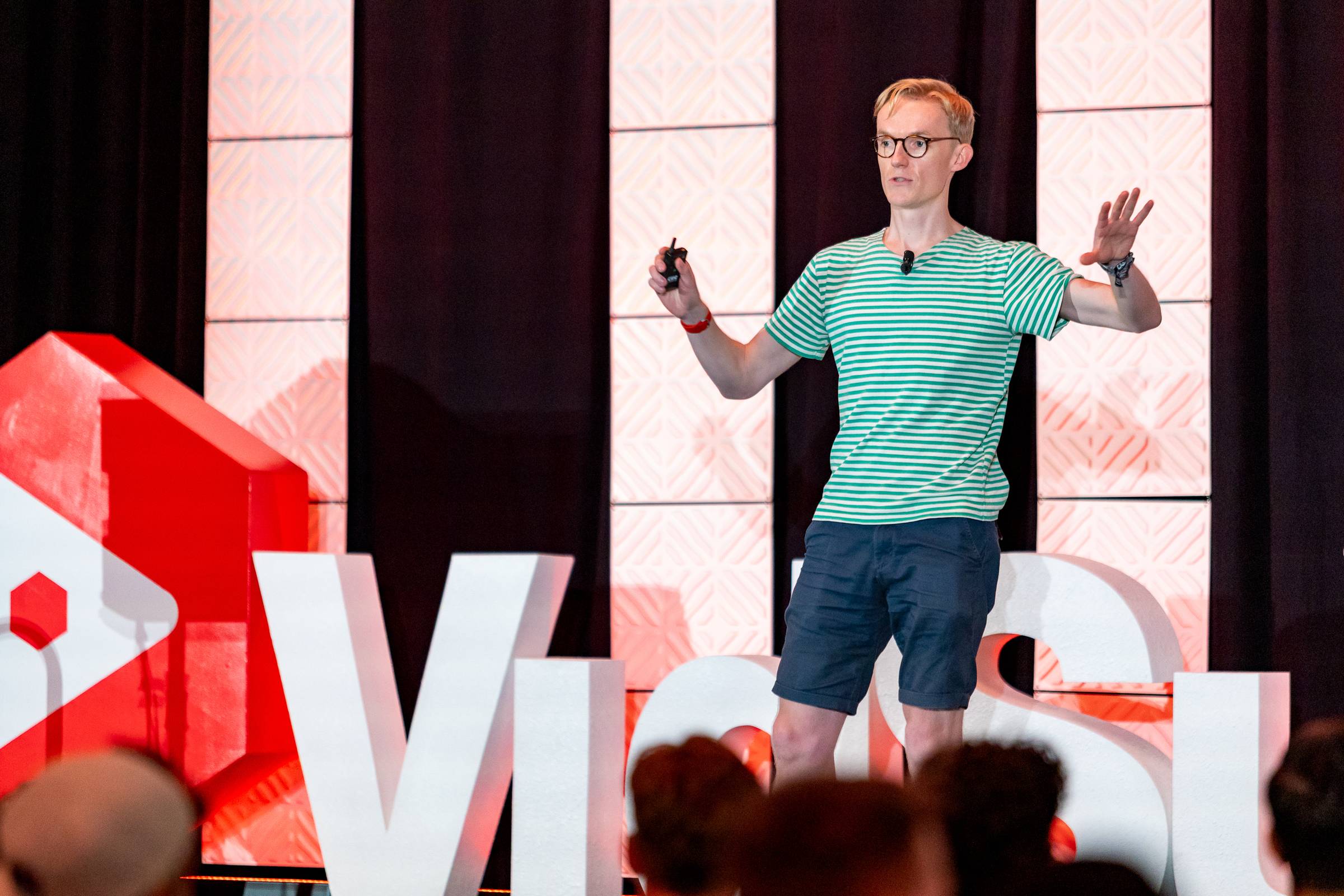
My talk was the very last of the entire conference, and considering the fatigue I was experiencing by that point, I was not expecting the turnout we got - somewhere in the region of 150 folks.
And it struck me - back in 2022, I was writing this newsletter to fewer people than that for months.
So to have the opportunity to speak to such an incredible group LIVE is making me teary eyed even as I write this!
Not only that, but I lost count of the number of you that I was fortunate enough to meet before and after the talk.
Newsletter readers, students, and even past clients - I will never take it for granted that (in our little pocket of the internet world) there are so many kind people that I've been able to connect with thanks to writing this newsletter.
From handshakes, to hugs, to sharing a few too many drinks on the final night... I'm honoured to have spent these few days with you 🫡
But let me say, regardless of whether you were able to attend VidSummit this year...
...the fact that you're reading this now - and the fact that you've ever opened one of my emails - is the reason that VidSummit were crazy enough to let me talk in the first place 😂
So thank you for your support! I'll endeavour to pay it back as many times as I can between now and next year with these emails.
That's all for this week.
Any questions? You can to reply to this email and I'll get back to you.
Speak soon,
George 👋
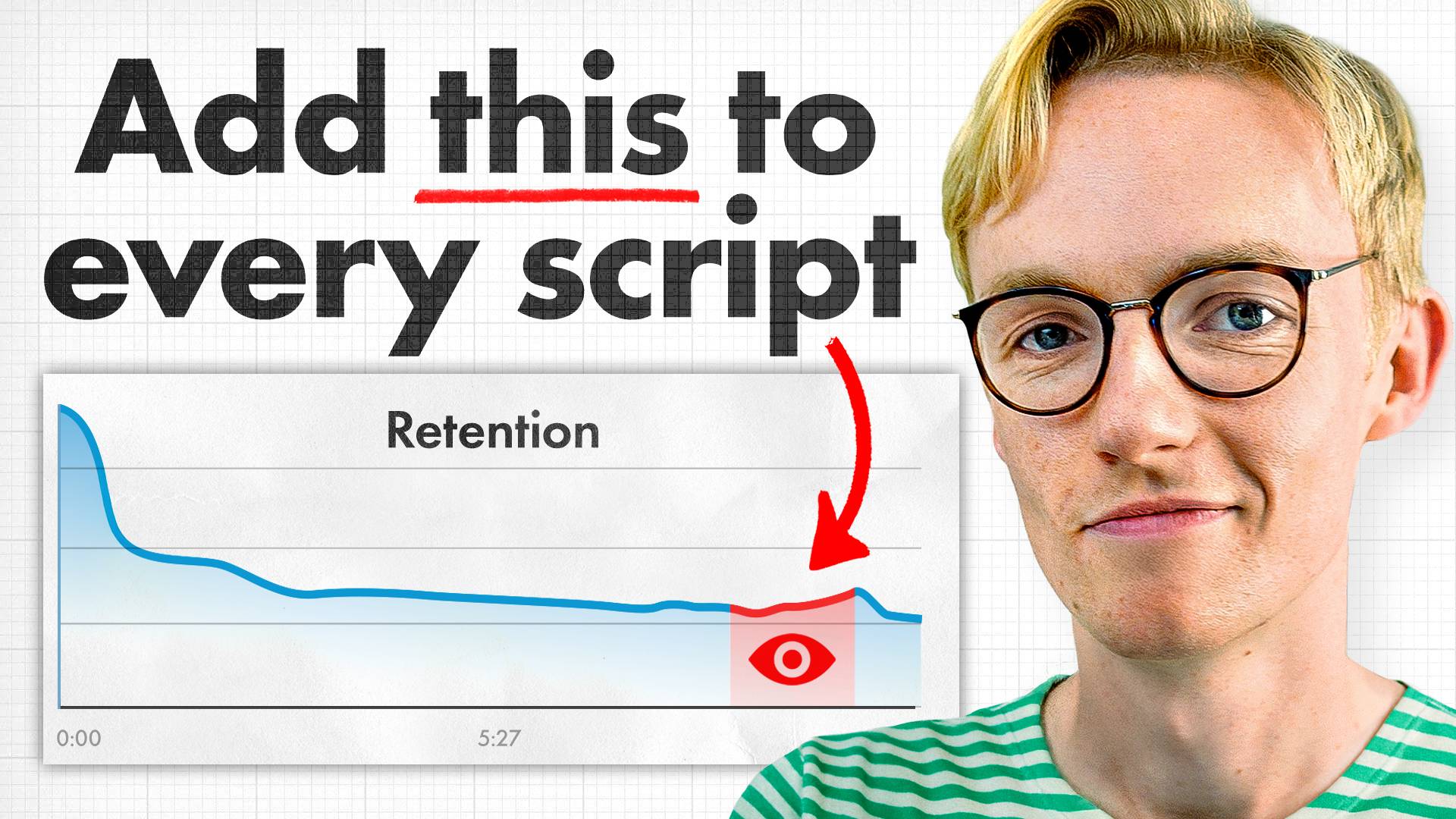
Revealing the "whirlpool" YouTube launch strategy
Assuming you're reading this on Friday… my YouTube channel just went live!

But this isn't a "go watch my video!" type email.
Instead, I want to share the weird launch strategy I’m using, and how you can steal parts of this approach even if you've already uploaded hundreds of videos.
How I combined two strategy ideas to create my own:
Inspiration for this launch strategy came from these two fellas:
- Nate Black → his recent “content wall” strategy: stop uploading for a month, then drop 3 videos simultaneously to reset YouTube’s idea of who your audience is.
- Ed Lawrence → Ed launched his current channel with 3 videos as well (one of which I wrote), and I remember him tactically linking 2 of them together with end-screen CTAs.
Both smart, both effective. But I wanted to push it further...
The "Whirlpool" Strategy
While I'm posting all 3 videos simultaneously (just like Nate and Ed), I wanted to create a truly bingable experience for my viewers.
That's why, using end-screens...
- Video 1 links to Video 2.
- Video 2 links to Video 3.
- Video 3 links back to Video 1.
That means, no matter which video viewers land on, they'll get pulled into a cycle that should (if the videos are good enough) get them to watch all 3.
Whereas one of Ed's videos linked back to his main channel... mine form a complete "circle".
And whereas Nate's technique relies on YouTube suggesting the three videos in the suggested tab... I've constructed end-screen CTAs intentionally to ensure viewers get pulled through all 3 videos.
But it doesn’t stop there.
I've already written and filmed videos 4, 5 and 6 - and each of those videos keep the chain going...
- Video 6 → links back to 5
- Video 5 → links back to 4
- Video 4 → links back to 3...
...at which point, they enter THE WHIRLPOOL!
What you can steal from this:
Whether you’re launching a brand-new channel or simply want to increase the value you're able to provide to your audience:
- ✅ Use end screen call-to-actions intentionally to guide viewers between videos.
- ✅ Try funnelling your viewers down to a small series of “whirlpool content”. If you’re launching your channel, follow the approach explored above. If you’ve already got several videos, identify 3 existing videos, and add end-screens which link between them.
- ✅ The videos you choose should be at the core of what you teach. (In my case, the 3 videos cover hooks, script structure, and end-screens.)
Want to watch the "whirlpool strategy" in action?
Ok fine - just a small plug :) I recommend starting here 👇

Click here to watch!
Free Live Session + Q&A With Me
Learn to write ready-to-record YouTube scripts in under 90 minutes.

While we're talking about the launch...
...I'd been "planning to start" my own channel for over two years.
But even with all my time-saving scriptwriting frameworks, I could never find enough time to make it happen.
So, after finding every excuse in the book, this year something finally clicked.
And with a cheeky little system and a few simple guardrails, I'm now writing and recording at a rate of one video per week.
Without it, I would not have been launching my channel today. (Let alone with another 3 videos in the can!)
I'm sharing that writing system with you for free on October 15th, at 5pm BST.
It won't be recorded, so if you want an inside look at how I write scripts for my channel (to help you write faster and upload more) make sure to sign up below:
That's all for this week.
Any questions? You can to reply to this email and I'll get back to you.
Speak soon,
George 👋
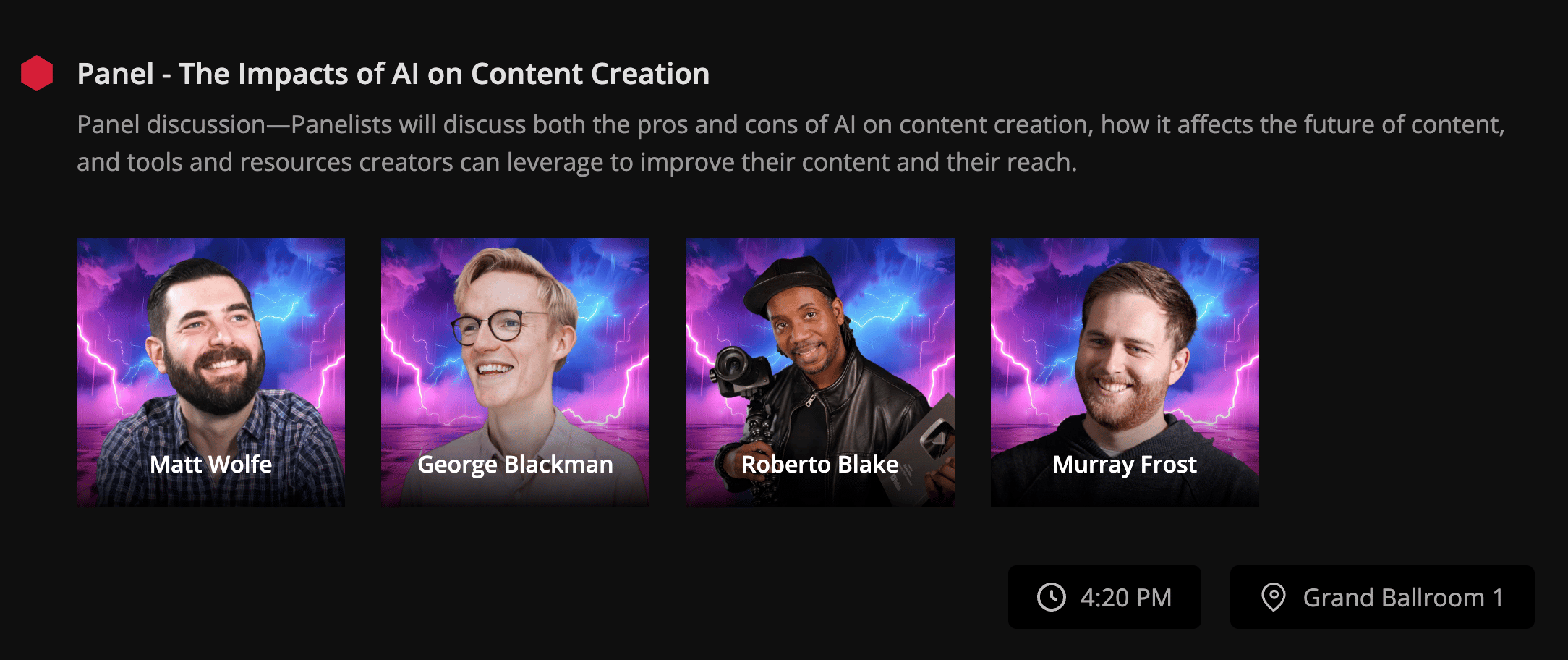
How much do you use AI?
After announcing my upcoming talk at VidSummit...
...I'm pleased to follow up with the news that I'll also be joining a panel called The Impacts of AI on Content Creation, alongside Roberto Blake, Matt Wolfe and Murray Frost.

With that said, I want to ask you something that might directly influence what I say on stage.
Because here's the truth:
Two years ago, I was still resisting AI.
But today, I use it daily, I sell an AI-based product, and I'm now going on stage (twice!) at the world's biggest YouTube conference as an "expert" on the topic 🤯
It got me thinking: it's amazing how much my attitude to AI has changed in a short span of time.
And I'll bet yours has too.
Maybe not in the same way, or at the same speed... but I'll bet it has.
And here's the coolest thing:
You and I are part of a pretty unique group, [FIRST NAME GOES HERE].
After all, the YouTube community is enormous...
...yet you, me, and 5700 other creators have specifically chosen to take scriptwriting more seriously.
And, as someone who made the investment in the AI Scriptwriting Toolbox, you're already thinking tactically about how to integrate AI into your scripts.
So, at a time when more and more people are asking questions like:
- Where should I use AI to make scripting easier?
- Can AI write whole scripts yet?
- How do I use AI without sucking the personality out of my channel?
Well... we're the people who are actually testing this stuff, figuring out how to integrate AI usefully into our workflow, and seeing what it's really capable of.
Which puts us in a pretty unique position.
So, with that in mind, I want to ask you 3 simple questions:
- How often do you use AI to help with scriptwriting?
- What do you use it for, specifically?
- When did you first start using it?
Click here to answer (takes 30s).
I'm putting everyone who answers into a hat and 2 random winners will get a prize:
- If you've never bought anything from me, you'll get lifetime access to the AI Scriptwriting Toolbox. (Value: $150)
- If you've bought the AI Scriptwriting Toolbox, you'll get lifetime access to the YouTube Scriptwriting Playbook (Essential tier). (Value: $397)
- If you're already a YTSP Essential member, you’ll get 6 months free Pro tier access (join the community). (Value: $599)
- If you're already a Pro tier member, you'll get a free 1-1 call. (Value: $1000)
I'm only invited to speak on a stage like this because of YOU!
So I want to get your voice heard while I'm up there:
Click here to answer (takes 30s).
That's all for this week.
Any questions? You can to reply to this email and I'll get back to you.
Speak soon,
George 👋
Create more engaging videos with simple, actionable scriptwriting tips.
Join 5,000+ scriptwriting nerds reading “Write On Time”. Insights from writing for multi-million subscriber YouTubers sent to your inbox every Friday.